► Hyundai’s distinctive new Santa Fe driven in the UK
► Hybrid or PHEV powertrain options, clever interior
► Roomy inside, and smooth to drive
For Hyundai, it seems that boxy is the new black. The brand’s massive new Santa Fe SUV shuns the idea of curves, low rooflines and faux-sporty detailing and prioritises space and practicality.
We’ve spent 48 hours in the new Santa Fe, exploring England and Wales in what may be the ultimate big family bus. Is it any good?
At a glance
Pros: Extremely roomy and useful interior, quiet and smooth, comfortable, distinctive
Cons: Slightly fiddly infotainment, PHEV e-range could be better
What’s new?
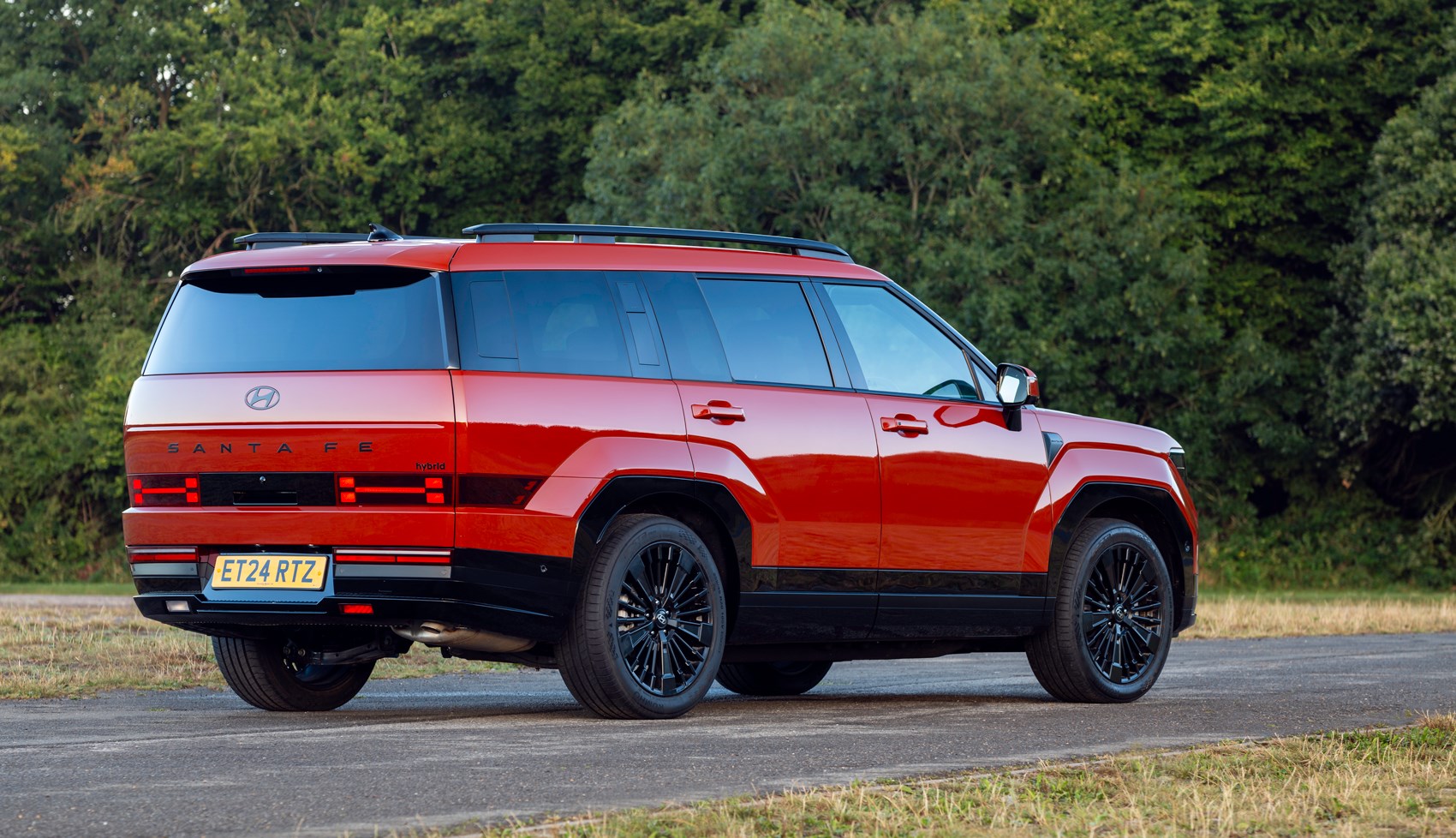
Hyundai’s massive Santa Fe SUV – its largest model in the UK market – is back for a fifth generation, and it’s a proper ground-up redo. The brand wowed us all when the covers came off, with this generation of Santa Fe opting for a boxy and modern aesthetic, with distinctive details like the new H-pattern DRLs, vents aplenty and a slightly more controversial rear-end design.
Simon Loasby, senior vice president at Hyundai’s design centre, says all of those boxy details are entirely deliberate, even calling this generation of Santa Fe ‘a brick.’ And, despite the boxy shape, the Santa Fe achieves a reasonable drag co-efficient of 0.296Cd.
Loasby says the idea for the Santa Fe’s new design came in the wake of the pandemic, when more people in Korea were spending more time having adventures and mini holidays with their cars, simply because they couldn’t go abroad. Loasby’s design team had the idea of crossing the line between a commuter for the week and a weekend adventure-mobile. In fact, a big trend in Korea right now is something called Chabak (cha meaning car, bak meaning sleep) whereby people do exactly that: sleep in their cars. ‘This is what we wanted to do,’ says Loasby; ‘create as much space for the consumer and the biggest tailgate to put everything you can into it.’
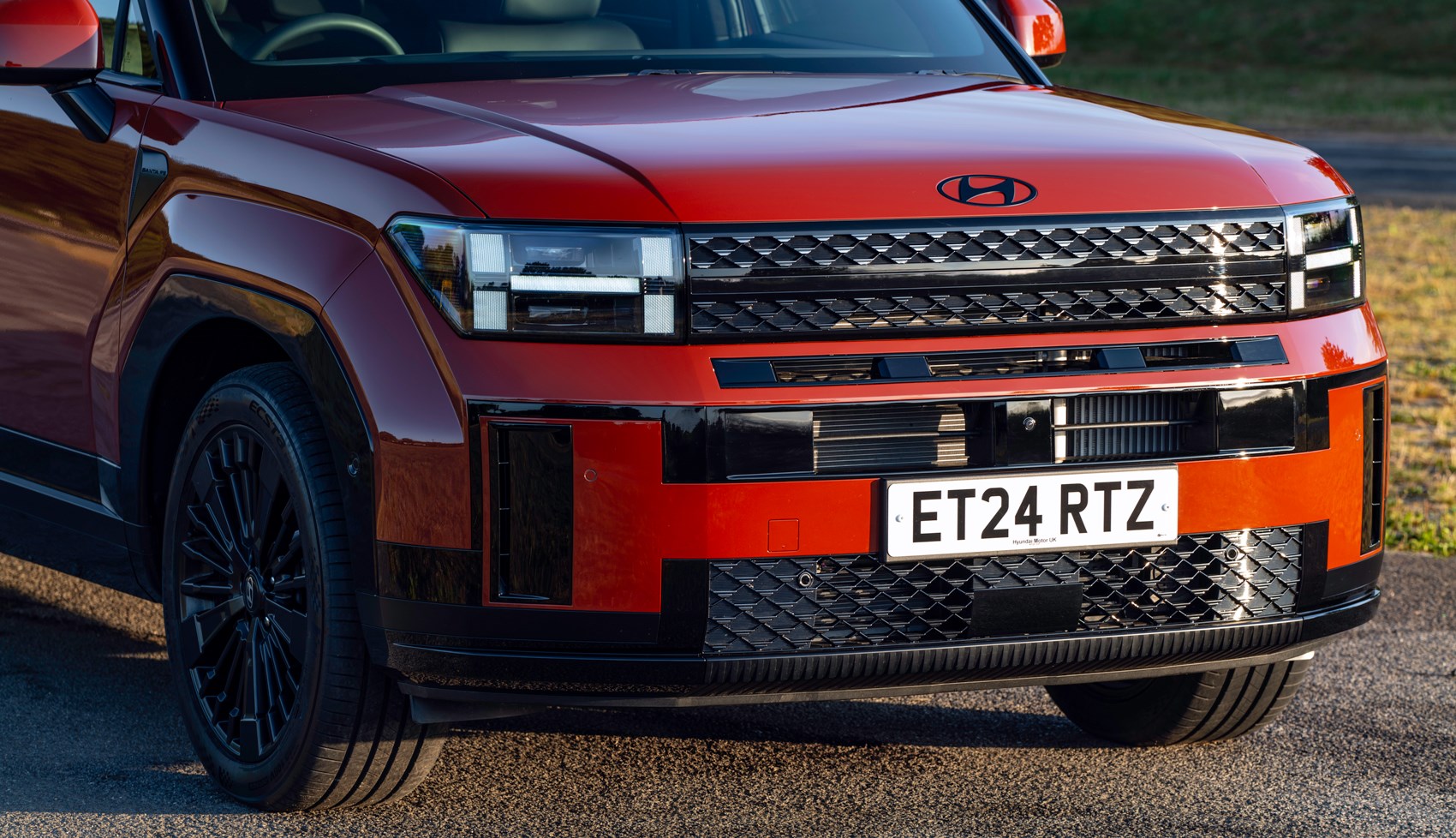
So much so that we experienced Chabak during our UK drive of the Santa Fe; want to read more about the experience of sleeping in a Santa Fe? Subscribers get exclusive extra stories via our newsletters and app – click here to become a member.
What are the specs?
There are plenty of choices for you to make. For the powertrain, your options are either a Hybrid or Plug-In model, and both models feature a 1.6-litre petrol engine. Both also feature tech like adaptive regenerative braking (which increases or relaxes depending on how close you are to a car in front, or a lowering of the speed limit) and both use a six-speed automatic – not a CVT seen in Toyota hybrids, for example.
The Hybrid model features a 1.49kWh battery pack and 64bhp e-motor helping provide drive to the wheels. It works in the way pretty much all conventional hybrids do, allowing for engine-off low-speed driving and a power boost under hard acceleration. Two- or four-wheel drive versions are available with the Hybrid. A 2WD Hybrid takes 9.6sec to reach 62mph, topping out at 112mph and claims up to 40.9mpg.
Go for the Plug-In model and the battery increases to 13.8kWh and the e-motor’s power increases to 97bhp. Plug-In models are also four-wheel drive only, with an acceleration time of 9.3sec and fuel economy of 161.2mpg claimed if used properly. Again, like any other plug-in hybrid, this model can be driven with the engine off completely, and Hyundai claims up to 33 miles of e-range is possible. That figure isn’t anything noteworthy, particularly when other PHEVs are launching with 60-ish e-miles available.
Then you get to the specifications: Premium, Ultimate and Calligraphy. You’ll notice a couple of quirks there; Ultimate isn’t the, er… ultimate trim, and Calligraphy very quickly reminded us of Land Rover’s own flagship Autobiography trim.
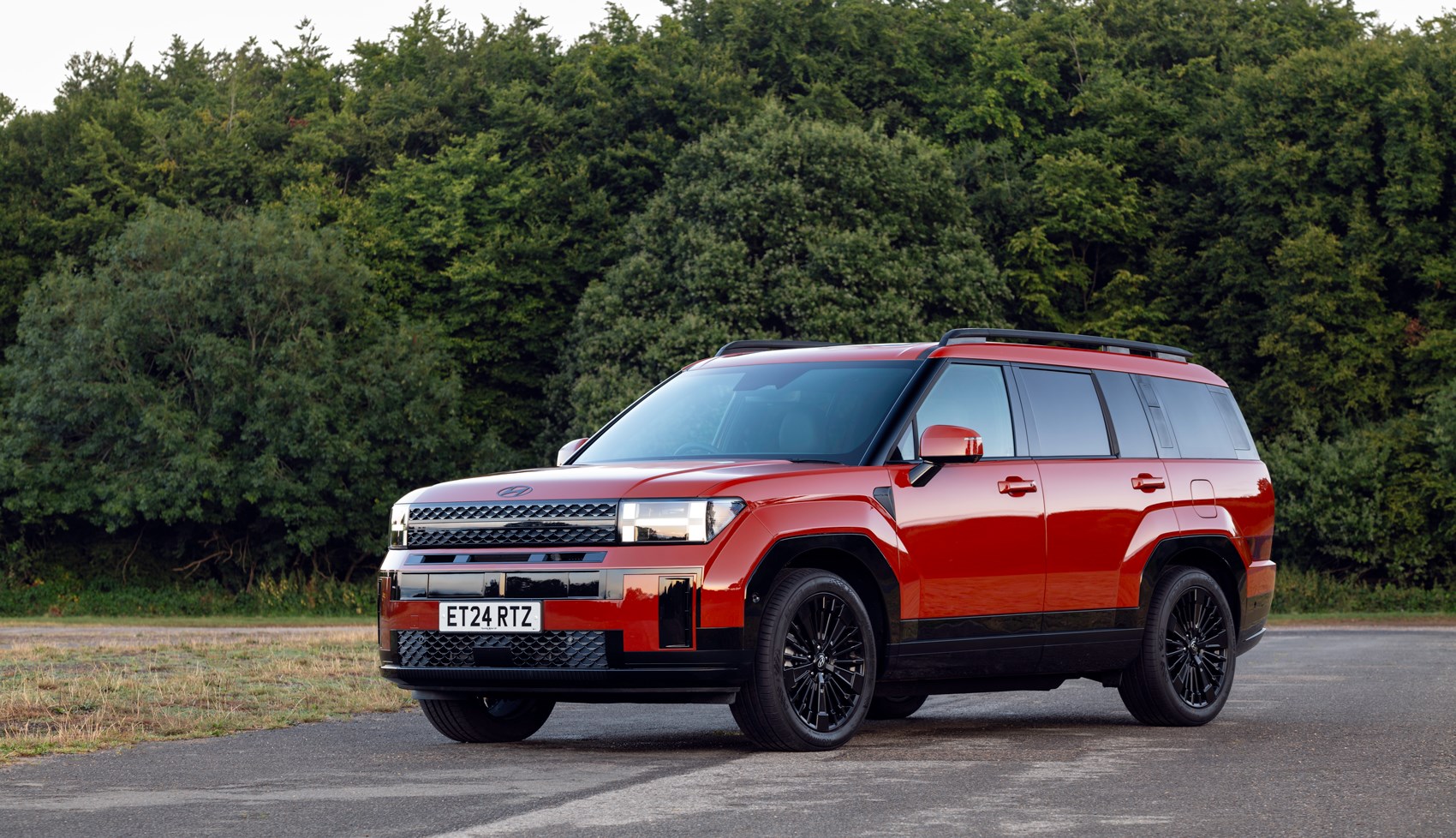
But even ‘basic’ Premium grade (starting from £46,775) is absolutely armed to the teeth with kit; as well as a huge amount of standard safety equipment, navigation (and, with it, navigation-based adaptive cruise) via an infotainment system that can be updated over-the-air, rear camera, powered tailgate, heated front seats a single wireless charger and 20-inch wheels. Ultimate (priced from £50,275) throws in cooled front seats, heated rear seats, glass sunroof, head-up display, Bose audio upgrade, a second wireless charger, Hyundai’s Blind Spot View Monitor (which we’ve tested separately here), 360-degree parking assistance and Hyundai’s ‘highway driving assist’. Choose Calligraphy (pictured in orange, priced from £52,775) and you’ll benefit from a black design package, Nappa leather upholstery, Hyundai’s relaxation seats (i.e.: full front recliners like you get in an Ioniq 5) and a neat compartment in the dashboard on the passenger side that includes a UV light sanitising compartment for your devices. Calligraphy models also feature a hidden grab-handle in the rear pillar to allow for easier access to the roof.
But wait! There’s more! As well as a seven-seat option, you can choose a six-seat model that includes a second row with two captain’s chairs instead.
What’s the interior like?
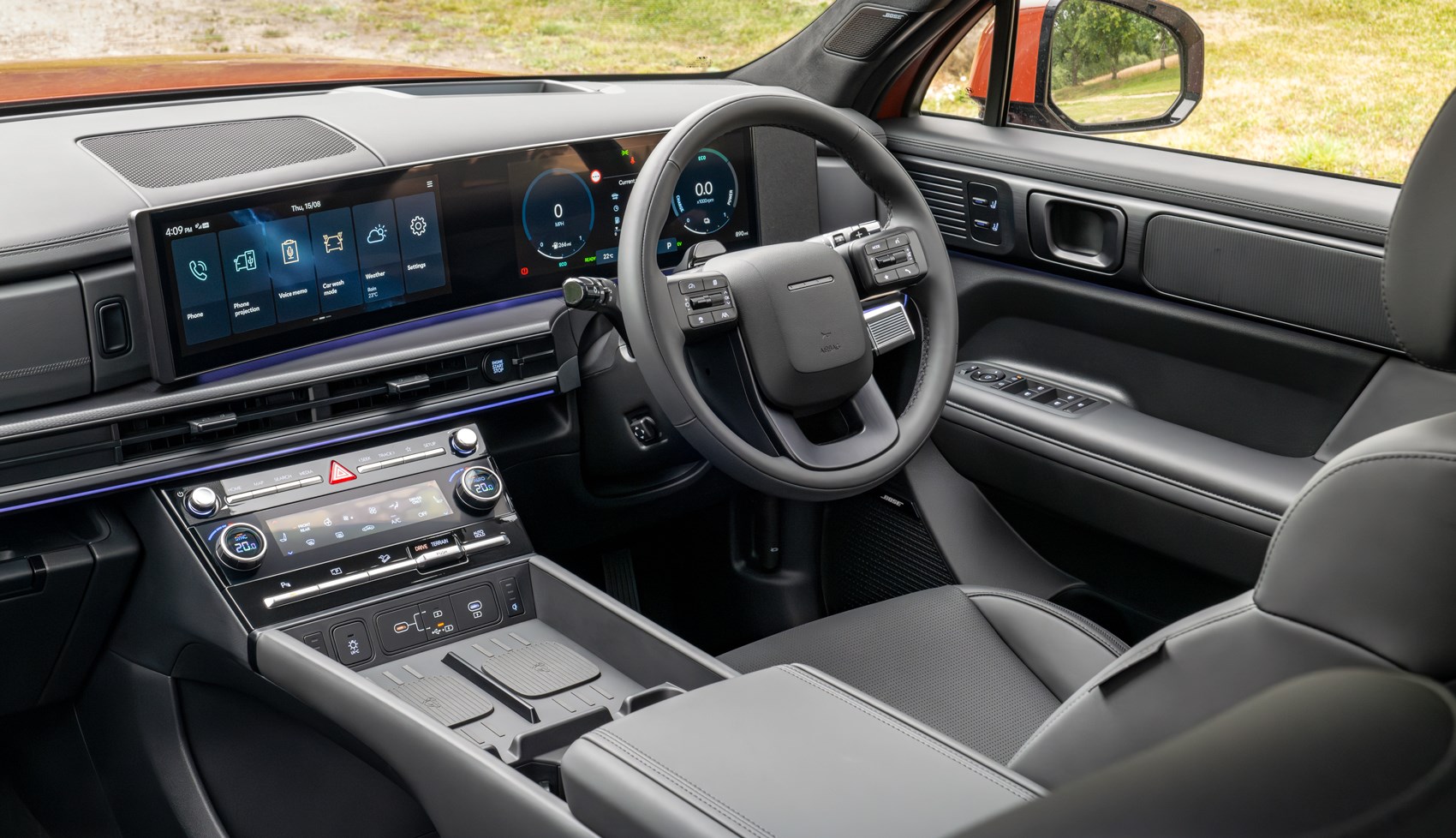
Hyundai’s played a blinder here, with the Santa Fe’s interior feeling well-built and posh but including lots of handy and practical touches. The driving position offers loads of adjustment and seat comfort is impressive – handy for long journeys and tall drivers. The steering wheel itself is chunky, with solid but soft-feeling materials on the buttons and Hyundai’s now conventional stalk drive shifter.
The two 12.3-inch screens that house the driver’s instruments and infotainment both look clean and read well, with simple instrument dials for the driver to read. The infotainment itself isn’t the easiest to use, mind – plentiful menus and some illogical placements of options make the experience a little fiddly. This criticism can be levelled at most Hyundai models (as well as Kia and Genesis models) however, as they all use the same system.
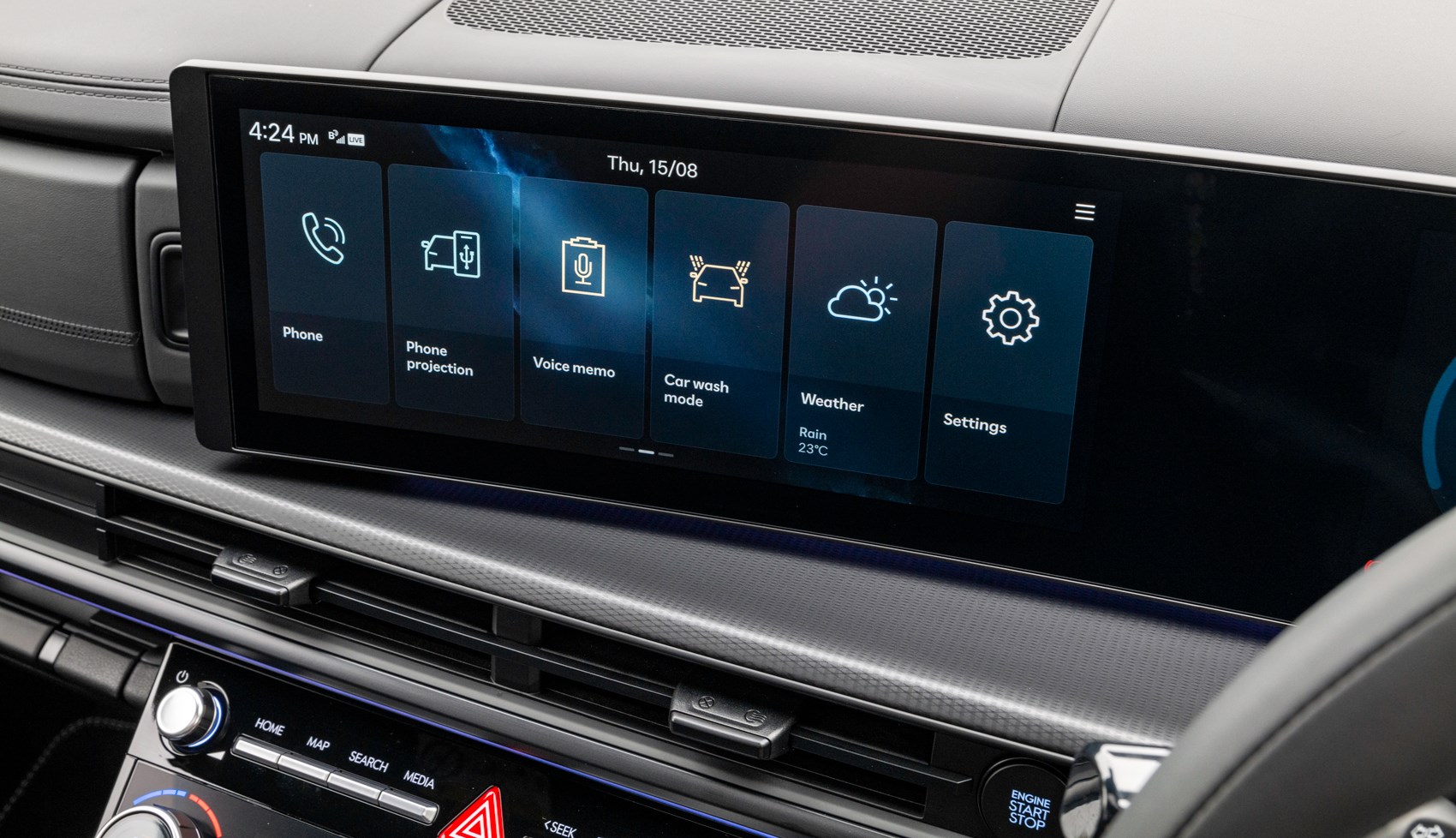
Happily, that’s counteracted by a large panel of physical buttons for quick access to certain infotainment screens, as well as some (but only some) physical switchgear for the climate control and drive modes.
Storage is plentiful, with decent-sized door bins in the front (which are bigger than they look), a huge storage area below the centre console and a massive central armrest cubby. Hyundai has placed wireless phone chargers right in the centre console, too. But it’s the smaller details that really make the interior feel handy: the smaller upper dashboard storage area for the passenger; divots just below the wireless charger pads for wires to be threaded through if your phone can’t actually charge wirelessly and a central armrest cubby lid that can be opened way by either the front or the rear passengers.
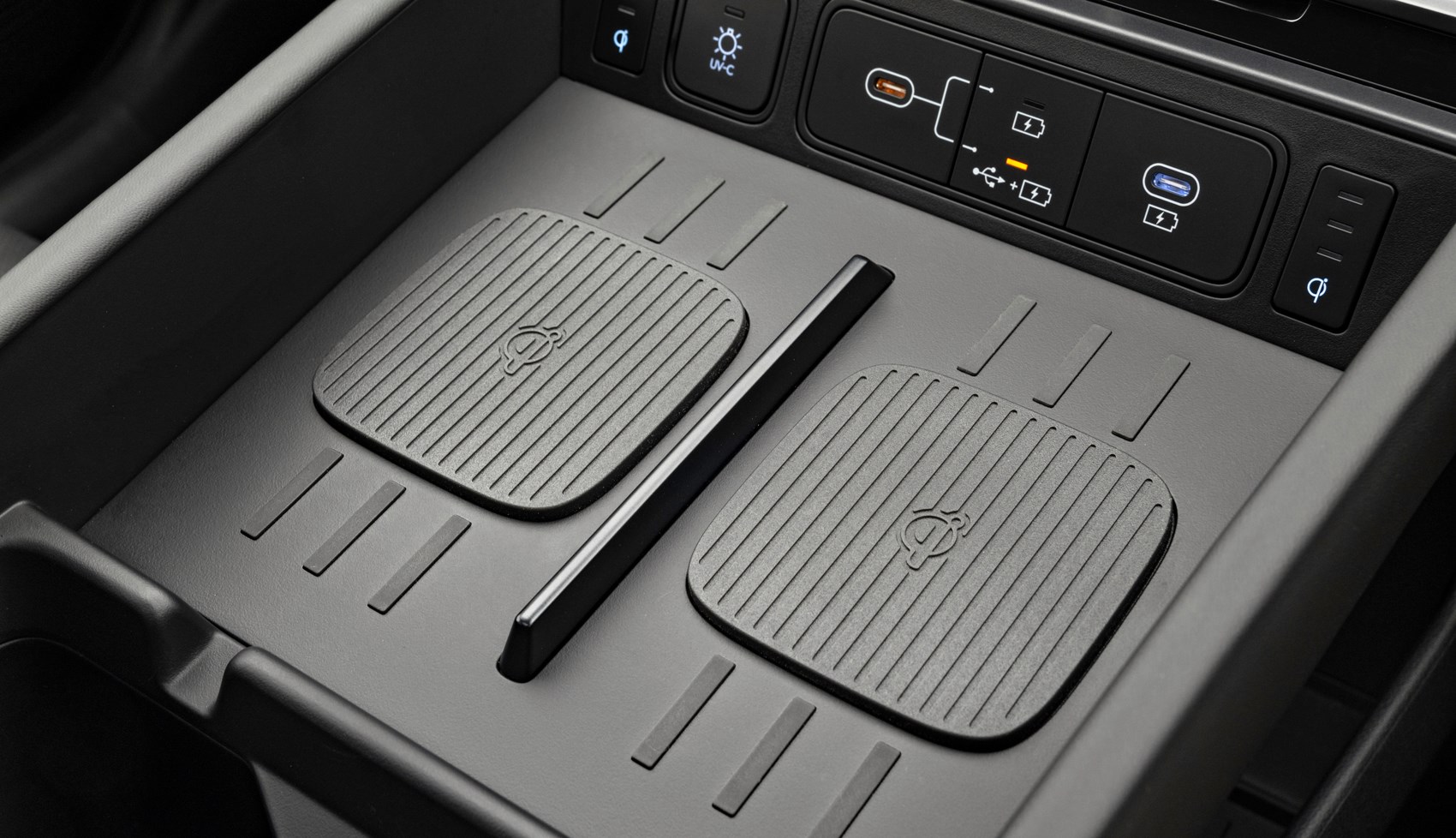
Speaking of the rear passengers, it’s palatial in the second row. Two cupholders and more large storage areas are in each door, as well as a bulk of charging ports and domestic power sockets available. Space is great for adults sitting behind tall drivers, and access to the third row is easy with powered second-row seating. Adults can sit in the third row, benefitting from good headroom and there are cupholders and charge ports here, too, but it’s still an ‘I’d-prefer-to-only-sit-here-for-a-short-while’ kinda deal.
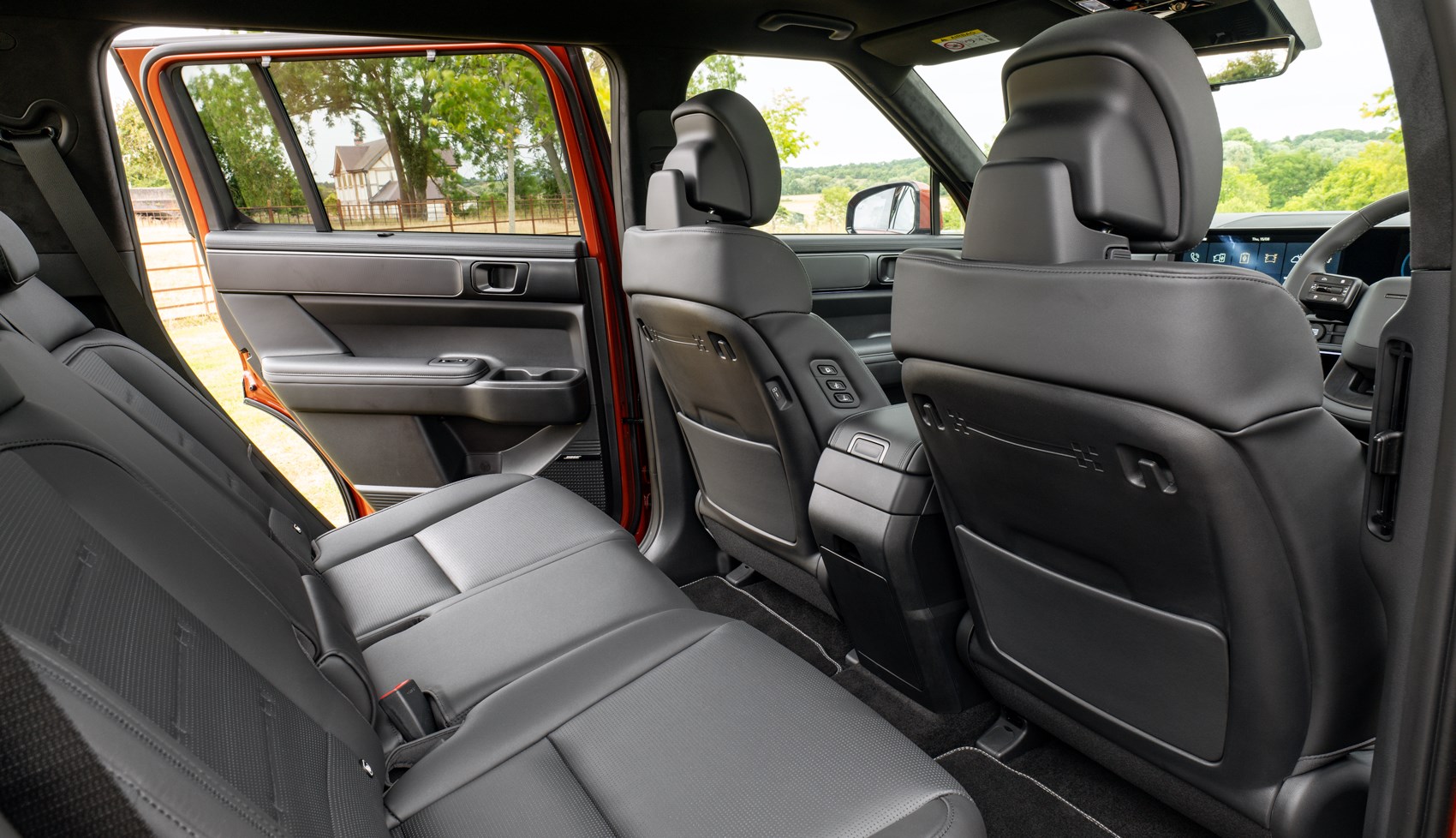
Boot space is impressive. Hyundai says – with all seven seats up – the Hybrid features a 628-litre space, and the Plug-In features a 621-litre one. That rises to 711 and 704 litres respectively with the rearmost seats folded, and up to 1949 and 1942 litres with all folded down.
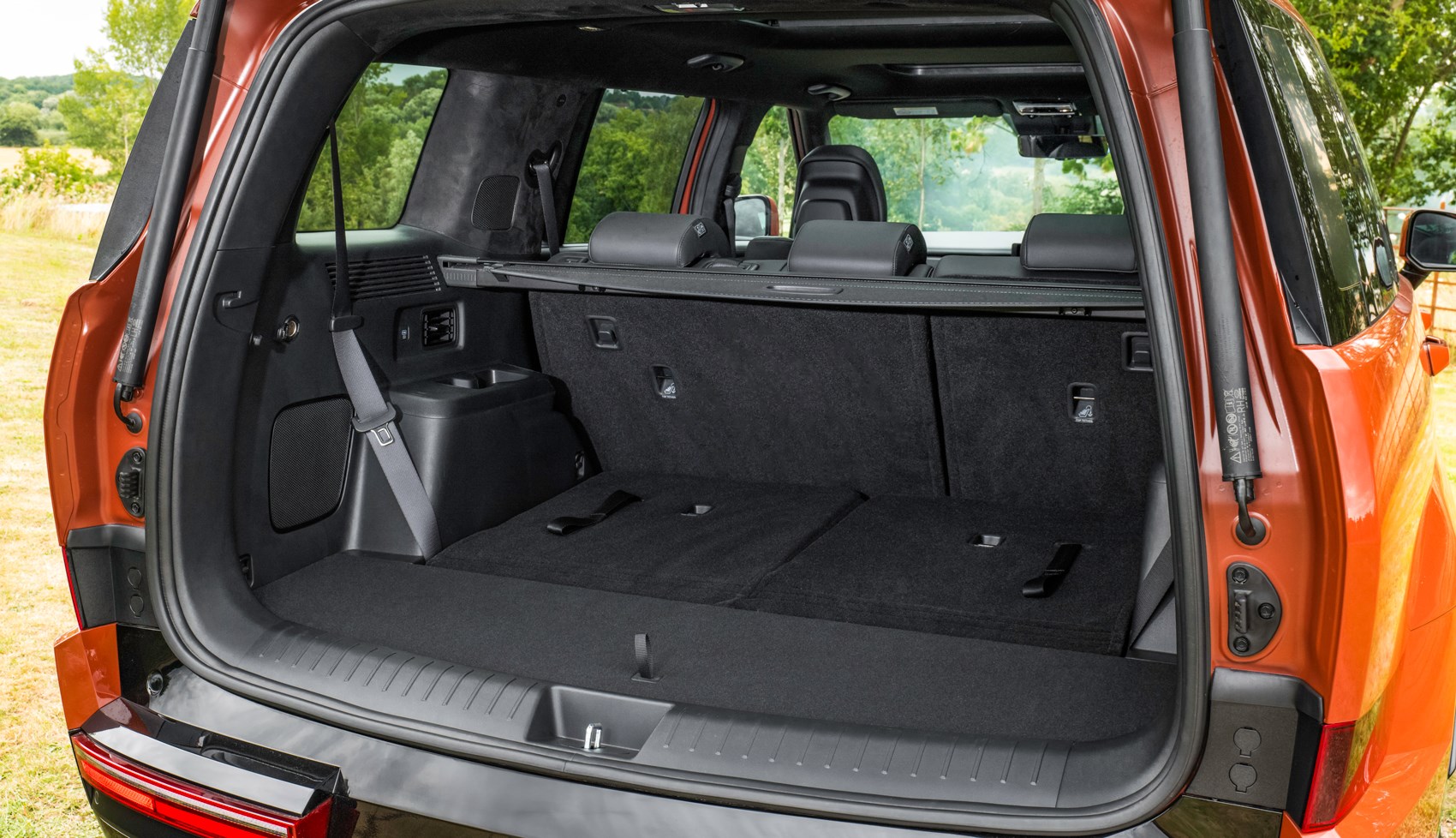
How does it drive?
Overall, it feels solid and dependable – if not especially exciting. But not many cars are exciting in this segment, frankly.
We’ve focused on the conventional Hybrid model, and it’s a very smooth and easy-going powertrain. The engine is impressively well damped in terms of noise, with the 1.6-litre engine almost sounding like it’s being revved in the car next door – even under hard acceleration. Well, we say hard – the Santa Fe’s performance is perfectly fine, with a sub-10-second 0-62mph sprint and enough shove for overtakes to happen without any bum clenching. Our 300-mile drive over a couple of days resulted in a circa 35mpg fuel economy, with the Hybrid’s claimed 40-plus-mpg figure seeming easily achievable.
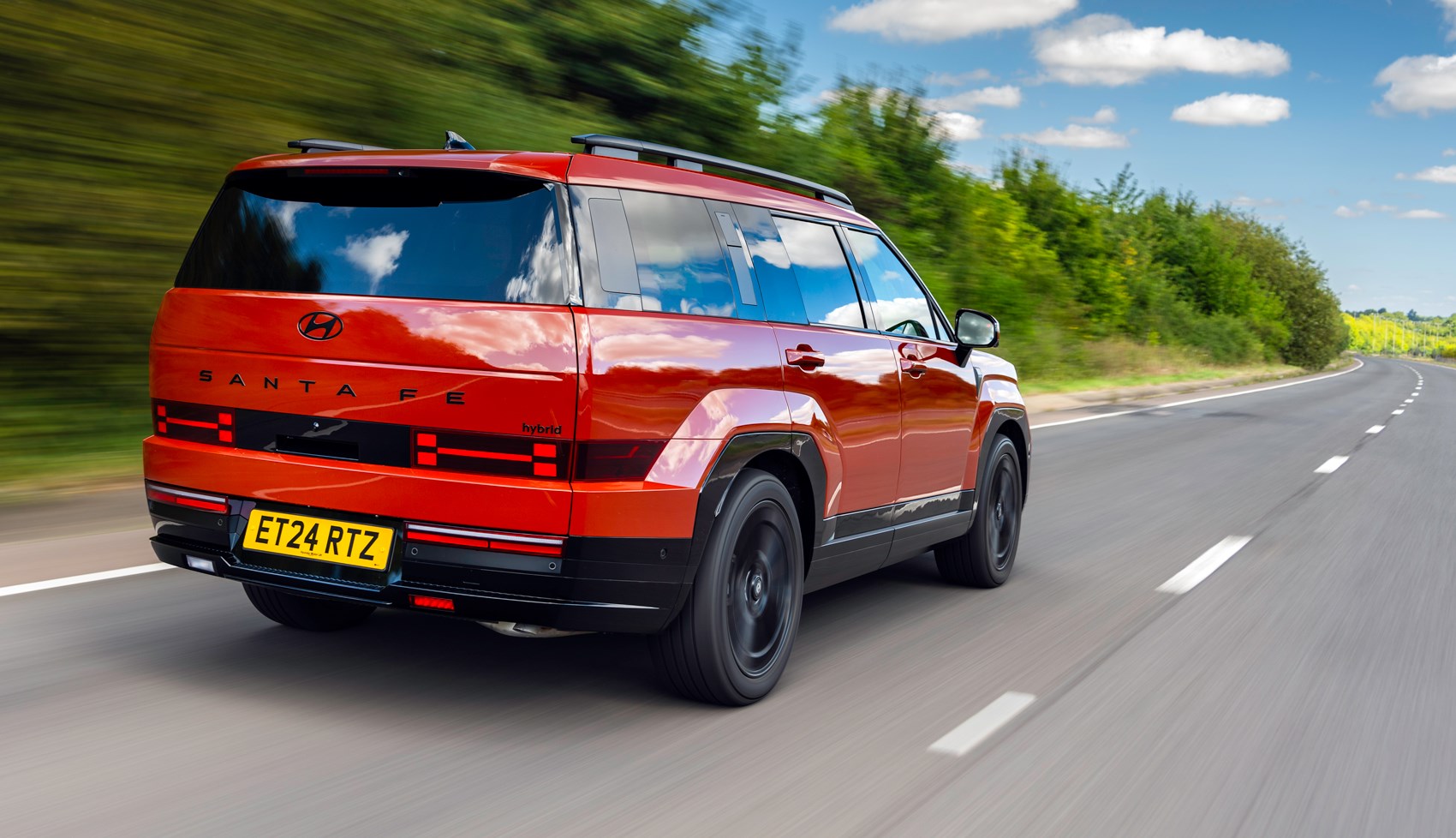
The steering is light and tidy and, like the powertrain, is designed to be inoffensive and easy-going rather than engaging. Holding the thick-rimmed steering wheel adds some confidence, and turn-in feels alert enough despite the Santa Fe’s large size.
What impressed was the ride; every Santa Fe runs on 20-inch wheels and, mostly, the quality on the road was good. Particularly large potholes jolt and thud a little, but small and medium imperfections in the road are dealt with well at any speed and the Santa Fe is a fabulous motorway cruiser. Wind noise isn’t too intrusive at higher speeds either, despite the Santa Fe’s shape.
It’s a neat and tidy machine to drive. It doesn’t feel as large as it looks on the road and, after a few hundred miles under our belts, we weren’t feeling sore or tired either. We’d happily say it’d make for a great road trip machine, which is arguably Hyundai’s main brief for the Santa Fe anyway.
Before you buy
Naturally, given the increase in quality and equipment, the latest Santa Fe’s price has been suitably pushed higher and slightly complicates its position. The circa-£50k Santa Fe is still a solid competitor for the very good (and less expensive) Skoda Kodiaq, which also offers seven seats, a good amount of tech and a plug-in option that costs from around £10k less than an equivalent Santa Fe (but only has five seats). But we’d argue the Santa Fe feels more upmarket these days, even compared to Skoda’s efforts with the latest Kodiaq.
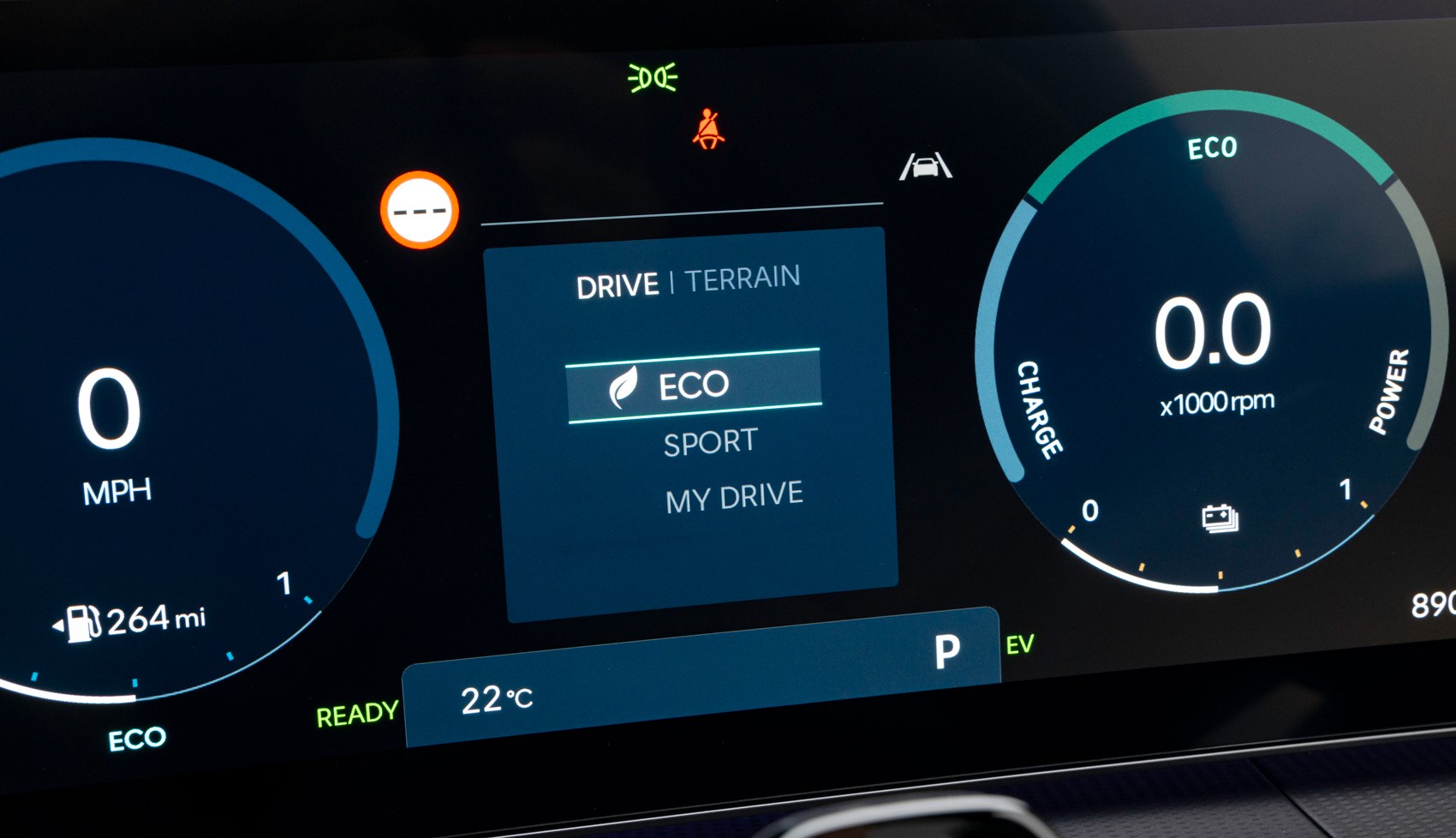
Which then puts it into the crosshairs of upmarket (and mostly German) rivals, where the Santa Fe confidently stands its ground – it feels like a relative bargain by comparison. Land Rover’s Discovery is £20k more and only available as a diesel, and the closest plug-in hybrid in size and space is a Range Rover Sport P400e, which is only available as a five-seater and costs around £40k more than the Santa Fe. A BMW X5 50e and Audi Q7 TFSIe are both very good, but also only available as five-seaters and still cost around £80k. Are those premium rivals worth that extra cash? We’re not convinced they are.
Verdict: Hyundai Santa Fe
Hyundai’s latest Santa Fe is its greatest, and by some margin. It’s a boldly designed family SUV that doesn’t forget to be practical and family friendly, with loads of space available for seven people and all of your stuff. Some neat bonuses also give the Santa Fe some individuality, and the interior quality is good enough to win over many that are also looking at large family SUVs from traditionally premium brands like Land Rover, BMW and Audi. So much so that we’d say it’s a convincing alternative to the likes of the Discovery, et al.
To drive, the Santa Fe is perfectly good enough if not particularly noteworthy here. It’s smooth and quiet on the road with the Hybrid easily achieving 40mpg, and handles neatly enough for what is a big boxy machine. Other plug-in hybrids offer more e-range but are a hefty chunk more money for the privilege. Its infotainment is a little fiddly, too.
But as a long-legged and long-life posh SUV designed for family life, the Santa Fe is distinctive to look at, interesting to sit in, easy to get on with and properly useful.
Yes, it’s a brick on wheels. But it’s a damn good one.
Specs are for a Hyundai Santa Fe Hybrid 2WD Calligraphy seven-seat